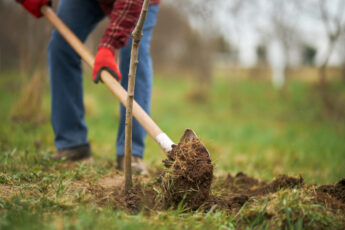Trees are the most important and resilient elements of our landscape. They save on energy costs by providing shade for our homes and neighbourhoods. They also increase property prices, reduce soil erosion and air pollution, and create animal habitats. They also make our daily lives more beautiful and peaceful. Trees provide oxygen, shade, and many other benefits as silent guardians of the environment. So, what do these trees need to grow and thrive?
Let’s discover the basic needs that allow trees to grow and survive!
Soil
Trees thrive on soil, which provides vital nutrients, water and structural support. Trees use their root systems to extract essential elements from the soil, including potassium, phosphorus and nitrogen. In addition, soil texture and structure are necessary for water retention and aeration, which promotes root growth and nutrient absorption.
Sunlight
Trees get most of their energy from sunlight, which powers photosynthesis, the process by which carbon dioxide and water magically combine to form glucose and oxygen. A sufficient amount of the sun is necessary for synthesising carbohydrates, which ensures metabolism and tree growth. The intensity and duration of the sun required by different tree species influence their distribution and ecological niche in various habitats.
Water
Life is water, and trees are no exception. Photosynthesis (the process by which trees convert sunlight into energy) requires an adequate water supply. In their natural environment, trees obtain most of their water from precipitation; however, in urban areas or during dry seasons, additional watering may be required to maintain good development. However, too much water can cause root rot and waterlogging, so well-drained soil is critical.
Space: Room to grow
Last but not least, trees need enough space to spread out their branches and roots to receive sunlight, water, and nutrients without competing with neighbouring plants. Overcrowding can hamper a tree’s ability to thrive, as it can cause stunted growth, greater vulnerability to disease, and competition for resources. It is vital to use appropriate planting and spacing techniques to ensure trees have enough space to grow to their maximum potential.
Nutrients: Building Blocks of Growth
In addition to sunlight and water, trees require a range of nutrients to support their growth and development. These nutrients, including nitrogen, phosphorus, potassium, and others, are absorbed from the soil through the tree’s roots. Each nutrient plays a specific role in the tree’s physiological processes, such as forming proteins, nucleic acids, and enzymes essential for cellular function and growth.
Environmental Factors: Temperature and Climate
Besides the essential elements of sunlight, water, air, and soil, tree growth is influenced by external conditions, including climate and temperature. Some tree species grow in tropical conditions, while others prefer the cooler temperatures in temperate zones. Different species have different temperature preferences.
Rainfall, humidity patterns, and other climate aspects are also important factors. While trees in wet locations may have larger leaves to improve moisture absorption, trees adapted to drier conditions may have mechanisms to conserve water. In addition, the development and survival of trees can be affected by extreme weather events, including hurricanes, floods and droughts. Some species can overcome these obstacles, while others cannot.
How to Help Your Tree Grow
Choose the Right Tree
Before planting a tree, it is essential to consider the temperature, soil type, available space, and mature size. Research native species that are successful in your specific environment to select a tree suitable for your particular environment. Choosing a suitable tree at the initial stage creates the conditions for good growth.
Planting trees can be great, but choosing the right location and plants is essential. Before you begin your project, consult with a local expert to ensure the area is suitable for planting trees.
Provide Adequate Water
Proper watering is essential for trees, especially in the early stages of growth. Constant watering is necessary for newly planted trees to form their root systems. Deep watering promotes stability and resilience by encouraging roots to grow lower.
Mulch for Moisture Retention
Mulching the base of your tree has several benefits. It adds organic matter to the soil as it decomposes, controls soil temperature, suppresses weed growth, and helps retain moisture.
Ensure Proper Drainage
Proper drainage is necessary to maintain healthy root growth. A tree with waterlogged roots is deprived of oxygen and is more susceptible to root infections due to poorly drained soil.
Prune Wisely
Pruning is a vital procedure that keeps trees healthy and stimulates their growth. Dead, diseased, or crossed branches should be removed to improve air circulation and reduce potential risks.
Book checkups
Healthy trees should be assessed once every three years, however mature trees can go a little bit longer. Early detection of disease or pest indicators can have a significant impact. Red flag signs such as cavities, cankers, discoloured leaves and more are what ISA Certified Arborists® look for. They then offer an action plan on how to help.
Following these tips and techniques can help your tree grow into a strong, healthy, and attractive landscape feature. Keep in mind that each tree is different and may require special attention depending on its species and requirements. If you receive the right care and attention, you can contribute to the sustainability and beauty of our urban forest for future generations.
As you plant new trees and care for those already in your yard, consider their variables. Contact Greenwood Tree Company if you have questions about tree care. We will be happy to answer any questions you may have.






